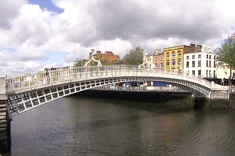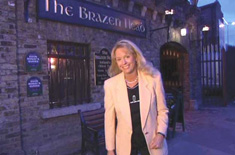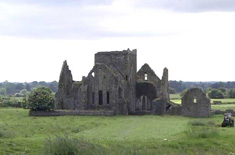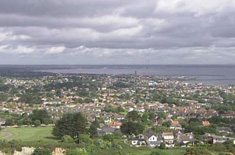Dublin
Where do you find a little Irish history and culture mixed with impressive modern touches? Why in Dublin! Ireland is one of the most beautiful countries I’ve been too and so full of surprises! You’ll be driving down the road and boom! You’ll see a castle, or an abbey or a cute little village and you say “Stop, I’ve got to take a picture!” Well, Ireland’s like that. It’s serendipitous.
If your idea of Ireland consists of cottages, castles and shamrocks, you’d be right to a point, but there is another side to the emerald isle that you may not know. It’s cosmopolitan, it’s diverse and it’s trendy. But never fear, it’s still full of traditional Irish culture and fun, just blended in with the latest design for a metropolis.
Capital of Ireland, Dublin is filled to the brim with great restaurants, a new tram system called the Luas, fabulous shopping and propitious pubs. But, the wonders of Dublin are not confined to her city streets alone.
 The natural wonders of Dublin are astounding from her view of the Wicklow Mountains and Dublin Bay to the River Liffey, which flows through the city, separating it into northern and southern halves. I’d call it alluring. Maybe just a little too tempting to foreign invaders, who for centuries, were drawn to the banks of the River Liffey. The first to invade were the Vikings who established a settlement where present day Dublin’s located. The Irish managed to get rid of this settlement but it was quickly replaced by the British, whose oppression lasted for seven centuries. The Irish revolted against the English, but it was the political maneuvering of their leaders in the 19th and 20th centuries that finally gave Ireland its independence.
The natural wonders of Dublin are astounding from her view of the Wicklow Mountains and Dublin Bay to the River Liffey, which flows through the city, separating it into northern and southern halves. I’d call it alluring. Maybe just a little too tempting to foreign invaders, who for centuries, were drawn to the banks of the River Liffey. The first to invade were the Vikings who established a settlement where present day Dublin’s located. The Irish managed to get rid of this settlement but it was quickly replaced by the British, whose oppression lasted for seven centuries. The Irish revolted against the English, but it was the political maneuvering of their leaders in the 19th and 20th centuries that finally gave Ireland its independence.
Today, there are lots of English influences in Irish society, from the language to the side of the road they drive on. But, aside from these, there are also concrete reminders of the British occupation.
Dublin Castle has stood as a symbol of British power in Ireland for over 700 years. In fact, the figure of justice above the ceremonial entrance has her back to the city, which many Dubliners interpreted as an illustration of just how much justice they could expect from their English rulers.
Every castle has to have guards, right? Well at Dublin Castle, the guards would stand with their guns and bayonets at ready, then they’d get off duty, and they’d go to the guard house to rest or sharpen their bayonets. You can still see the grooves in the stones outside the guard house.
The castle has served as a royal residence, the parliamentary building, a military garrison and home to the lower courts. Today, it’s mainly a tourist attraction, although conferences and presidential inaugurations do occur here as well. But who knows what other purposes the castle might have performed, it’s still revealing its secrets. In 1986 they were digging underground doing renovations and they discovered part of the moat, a thirteenth century tower, and the city wall. There is even an archway where the boats would come through to the castle to unload the provisions used in the castle.
Another building that stands as a reminder of the British occupation is St. Patrick’s Cathedral, which began its career as a Catholic church. However, was taken over by the Protestants after the Reformation. During its history, the church held many responsibilities: as a burial ground, tourist attraction, host to national ceremonies and a university. In fact Queen Elizabeth considered St. Patrick’s as the home of a new Irish college, but that title went to Hallows Monastery, which is now known as Trinity College.
With its history of oppression behind them, the only invaders to Dublin today are the tourists who flock to the city’s famous attractions and pubs. And while Dublin’s reputation for outgoing hospitality is nowhere near what it used to be, probably due to its new and younger prosperity, the folks here are still pleasant enough.
And for some of that camaraderie of yesterday, I found the most inviting part of Irish society is their pub culture. Before you go on a pub crawl, you’ve got to take three things: one, a sense of fun, two, your Guinness t-shirt; and three, the knowledge of an old Gaelic saying, which goes, ‘Iisminica vreesh bail de ashrone.’ translated, that means, ‘a person’s mouth often gets his nose broken.’ Think about it. Say the wrong thing, pow.
But the one thing you won’t have to bring is craic, spelled “c_r_a_i_c” (pronounced crack) because they have plenty of that in every Irish pub. What’s craic you ask? Roughly translated it means good conversation and fun. Now bars in America might conjure up images of drinking dens, but pubs serve a much higher purpose in Ireland. Here, they’re the social centers of the community. And, while taverns in Dublin are not as cozy as their country counterparts, they’re still the place to go to soak up a little Irish dancing and music.
A good place to start is at O’Donoghue’s! One of the most famous pubs in Dublin! Here’s where you come for some good Irish whiskey, a pint of Guinness, and some live, traditional Irish music. Along with the music comes some real Irish dancing, jigs and all. I’d love to be able to do that!
 You don’t need to drink to enjoy an Irish bar, but it sure helped put me in the Irish mindset! And if you’re going to drink, then there’s another Gaelic word you have to learn. It’s pronounced “slainte” which roughly translates to cheers.
You don’t need to drink to enjoy an Irish bar, but it sure helped put me in the Irish mindset! And if you’re going to drink, then there’s another Gaelic word you have to learn. It’s pronounced “slainte” which roughly translates to cheers.
And what should you be drinking? Well, that’s easy! It has to be a Guinness! Now you’ll find a pretty good pint just about anywhere in Ireland, but the place that touts the best pint is at the top of the Guinness factory, called the Gravity Bar! It’s here that I learned what makes a perfect pint, and it’s not just the freshest ingredients, it’s also the pour. There’s a knack to every in life, but pouring the perfect pint takes six specific steps which are mandatory. What you do first of all, is grab a nice, clean, dry glass. You put it a forty-five degrees angle, up against the nozzle, pull it forward towards you, till it comes up to a quarter’s way high on the glass. Pay attention to this next part….it’s the most important. You just sit back and let it settle for two minutes. That’s the secret! What’s happening in those two minutes, believe it or not, is the gas, is mixing of the gas, its nitrogen and co2.
Once it has settled, it’s still not done yet. You have to put the top on it. You keep the glass straight this time, we don’t tilt the glass at a forty-five degrees, you keep it straight, then push it back, this time, not forward. And the foam goes just to the top rim, no spillage allowed. So that’s what you call, a perfect pint. And what do you do with a perfect pint? You drink it of course. “Slainte, everyone.”
But don’t take your Guinness and run, there’s much more to the factory than just the perfect pint. There’s a museum, a store and even a Guinness waterfall. But I found the most informative thing at the factory was my lesson on how to appreciate a good pint. The staff is happy to teach you how to professionally taste Guinness using all of your five senses.
First you hear the hiss of the gases mixing. Next, you look at the pint to appreciate its color, which is not chocolate brown, but rather a ruby red. Hold it up to the light and you’ll see. The third step is to touch the glass. It should be cold since a proper pint is served at exactly 6 degree Celsius or 42.8 degrees Fahrenheit, no warmer, no colder. Now fourth stage is to smell the pint. It should smell burned, from the roasted barley, sugars from the malted barley, and a very strong smell from the hops, because the hops are what give it its bitter taste. Of course, you knew that, right?
The fifth stage, which is my favorite, is tasting the Guinness. Apparently it’s a lot of people’s favorite, but, even this, is more complicated than it appears. You take a deep breath in, through your nose, don’t breathe out, take a sip of your Guinness, swallow and breathe out. Now that is called retro-nasal breathing. Very technical term for how professional tasters taste Guinness. You should notice that there’s a much more, sort of strong taste from the Guinness. Then take a larger drink in the same way. Where you should be feeling that, is at the back and the left side of your tongue, because that’s where your bitter taste buds are. So it should be a stronger tingle than it did from just a sip.
Ah! And if you think the Guinness is good, be sure to check out the view from the Gravity Bar, it’s perfect. Just makes you want to get out and see the town. But wait, before you do, there’s something to remember. A lot of the things you’re going to want to see in Dublin are not exactly accessible to everybody. Wear comfortable walking shoes and remember; ramps, they don’t have everyplace. Stairs, they are found everywhere. You’re going to have to hoof it. With that said…on to the attractions!
What remains of the old city wall is almost eight hundred years old, and there is very little left of it to see. In fact, right in front of the remaining section of wall used to be called Cook Street. Back in the old days, this is where they would do all of the cooking; everybody would be lined up and doing all the food for inside, because they were afraid to start fires inside the buildings. A lot of the streets were named after things that were on them, like Bull Alley Street and Sheep Street. I wonder if there was Jewelry Street. Bet there was.
 While its name may not be great stuff you’ve been looking for street, that’s exactly what you’ll find on Grafton Street. Because, whether it’s mobs, music or merchandise, they’ve got it. Hey! It’s cheaper than it looks on Grafton Street. They have VAT refunds, value added tax, that you can get back because you’re a foreign visitor. Between 13% and 21% you get back. Now that’s incredible. And you know what? If you can find a sale, ah, faith and be glory, you’re lucky as a leprechaun. And when you’re traveling what else is there to shop for than souvenirs?
While its name may not be great stuff you’ve been looking for street, that’s exactly what you’ll find on Grafton Street. Because, whether it’s mobs, music or merchandise, they’ve got it. Hey! It’s cheaper than it looks on Grafton Street. They have VAT refunds, value added tax, that you can get back because you’re a foreign visitor. Between 13% and 21% you get back. Now that’s incredible. And you know what? If you can find a sale, ah, faith and be glory, you’re lucky as a leprechaun. And when you’re traveling what else is there to shop for than souvenirs?
You know a lot of people come to Dublin to go to the genealogy museum to discover their family history. Well, for those who have a little more casual interest in their Irish background, you can discover your family crest, if there is any Irish blood running through your veins. I looked, but I wasn’t there. I think I’m from Scotland, but they told me that the Scots dropped the “a” out of the “Mac” when they came to Ireland after the upheavals.
You’ll love the maze of medieval streets that mixes with modish outlets creating a unique shopping experience. Dublin has a lot of little areas and neighborhoods, which I love and one of my favorites is most definitely the Temple Bar area. It’s kind of a redeveloped pedestrian zone now, really cute, with cobblestone streets. It’s filled with restaurants, bars, music, pubs, and it’s great for anyone looking for a colorful night life.
But it wasn’t always like this. In the 20th century, Temple Bar suffered from urban decay and was abandoned to Dublin’s derelicts. Through renewal projects, these medieval streets were transformed into the city’s center for culture and shopping. While you’re in Temple Bar, take a moment to search out one of the city’s most famous landmarks… the Ha’ Penny Bridge. The actual name is Half Penny Bridge, because until 1919, you had to pay a toll to cross. Thankfully today it’s free.
Before you visit Ireland, you need to pack for fickle Irish weather. Summer in Dublin is the warmest it’s going to get, obviously, but even then it’s kind of cool, it only gets up in about the 60’s. When it clouds over, starts to rain, you know what? You’re gonna freeze! The best advice I can offer, is to wear layers and have either a raincoat or folding umbrella handy for occasional showers.
While you transverse Dublin, you’re bound to run into one or two of its famous Georgian neighborhoods. You’ll see a green door, a blue door, a black door, a red door, a yellow door. Apparently in the late seventeen hundreds, a man coming home wanted to make sure he was getting in the right bed, so he’d paint his door a little bit different color from his neighbor’s. However they do have a lot in common, yet still slightly different. They all have the peacock windows, they all have the boot scarpers and some, if they were really special would have a lantern light over the door so they could light a flame to bring them home. Some of these homes are still residences today, but many of them have found new lives as offices, apartment complexes and even shopping malls.
To give you an idea of how Dublin’s changing, take a look at the Powers Court Center. Here, they’ve taken an old, run down building, and instead of demolishing it, they incorporated new architecture into a brand new shopping mall. They are sort of retaining the historic value of the property, while giving it a brand new look.
Now, not all of the old residences have been reinvented. Some have been preserved to commemorate the lives of the people who lived in them. Every building has a story here in Dublin and the stories that really matter get a plaque. Take the circular placque on Oscar Wilde’s old home. You know, The Importance of Being Earnest, The Portrait of Dorian Gray. It tells me when he was born, when he died, when he lived here, and what he did. You check the plaque, you get the scoop.
Can’t get enough Oscar? Well then go and see him for yourself. Across the street from Oscar Wilde’s house is a little park where you can see Oscar, himself, lounging on a rock, totally misunderstood. And then they have little columns that show some of his sayings, like ‘experience is the name everyone gives his mistakes,’ yes. And ‘I can resist everything except temptation…and chocolate.’
 If you are a book buff, then you’re on the right island because Ireland is home to numerous literary greats from, Samuel Beckett to Roddy Doyle. But a true Dubliner will tell you the city’s literary treasure was James Joyce, whose works like Dubliners and Ulysses described life in 20th century Dublin. And, if you want to see James, than head to St. Stephen’s Green, which, despite its central location, is a beautiful oasis from the busy city.
If you are a book buff, then you’re on the right island because Ireland is home to numerous literary greats from, Samuel Beckett to Roddy Doyle. But a true Dubliner will tell you the city’s literary treasure was James Joyce, whose works like Dubliners and Ulysses described life in 20th century Dublin. And, if you want to see James, than head to St. Stephen’s Green, which, despite its central location, is a beautiful oasis from the busy city.
For a truly luxurious respite from the hustle and bustle of the city than you need look no further than the Four Seasons Dublin. At the end of a busy sightseeing and shopping day, you’ll be ready for the perfect place to relax and unwind. And the Four Seasons Dublin enjoys a unique vantage point to explore the city’s museums, music and historic sites. It offers the city’s most extensive selection of accommodations, from modest to the most luxurious and spacious rooms in the city! Their presidential suite is the most elegant in Dublin, featuring both a dining room and a sitting room. After a night in the Four Seasons Dublin, you will begin to consider it one of Ireland’s national treasures.
But if you really want to see the Irish jewels, well, I hate to say it, but they were stolen from Dublin Castle in 1907. Take heart though, there are plenty of other valuables to enjoy at the National Museum of Ireland which is filled with everything from gorgeous silver and pottery to military items dating back to 7000 BC! The highlight of the museum though is the Fonthill Vase, which dates back to the Yuan Dynasty in the 13th century. It is world renowned as one of the best documented pieces of early Chinese porcelain.
But you don’t have to go to a museum to appreciate the riches of Irish society. It’s all around Dublin. From the traditional pubs to the trendy shops of Temple Bar, they’ve managed to encompass not only the conveniences of a modern metropolis but an enclave of traditional Irish values, all on the banks of the River Liffey.
